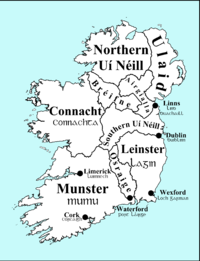- Kingdom of Osraige
-
Osraige Country Ireland Ancestral house Ulaid / Érainn Titles - Kings of Munster
- Kings of Leinster
- Kings of Osraige
- Kings of Corcu Loígde
Kingdom of Ireland titles:
- Lord Baron of Upper Ossory
- Earl of Upper Ossory
- Baron Gowran
- Baron Castletown
The Kingdom of Osraighe (older spelling: Osraige, reformed spelling: Osraí), anglicized as Ossory, was an ancient kingdom of Ireland. It formed the easternmost part of the kingdom and province of Munster until the middle of the 9th century, after which it attached itself to Leinster. Ossory was allied to the powerful Corcu Loígde or Dáirine of Munster for several centuries before the rise of the Eóganachta in the 7th century, and is said to have provided a number of prehistoric kings of Munster under the alliance. The new political configuration, probably the result of an Uí Néill-Eóganachta alliance against the Corcu Loígde,[1] caused a reduction in Ossory's relative status, and its kings to thus seek their fortunes in Leinster.
The Osraige—their name means people of the Deer—inhabited much of modern County Kilkenny and parts of neighbouring County Laois. To the west and south, Osraige was bounded by the River Suir, to the east the watershed of the River Barrow marked the boundary with Leinster, and to the north it extended into and beyond the Slieve Bloom Mountains. The medieval Diocese of Ossory covered much the same region.[2] Its most significant neighbours were the Loígsi, Uí Cheinnselaig and Uí Bairrche of Leinster to the north and east and the Déisi Muman, Eóganacht Chaisil and Éile of Munster to the south and west.[3]
In the earliest times, the church at Domnach Mór Roigni (now Donaghmore, County Laois) may have been the chief church in Osraige, but in historic times it had been eclipsed by Aghaboe (County Laois), chief church of Saint Cainnech, since replaced by Kilkenny, and Seir Kieran (County Offaly), chief church of Saint Ciarán of Saighir. The record of the Irish annals also points to Freshford (County Kilkenny) being of some importance, while archaeological evidence suggests that Kilkieran, Killamery and Kilree (all County Kilkenny) were significant ecclesiastical sites.[4]
In historic times, the territory was ruled by the Mac Giolla Phádraig or FitzPatrick dynasty until their submission to Henry VIII of England in 1537.[5] In 1541 The Mac Giolla Phádraig was ennobled as Baron Upper Ossory, and other members of the family were subsequently created Earl of Upper Ossory and Baron Castletown.
A celebrated king of Osraige was Cerball mac Dúnlainge, ancestor of the medieval and modern FitzPatricks. He was also so close to the Norse that he features in many medieval Icelandic pedigrees through his daughters, giving the FitzPatricks a unique and celebrated genealogical position in Northern Europe.
Gofraid mac Arailt, King of Mann and the Isles, through his daughter Mael Muire, appears to have been the maternal grandfather of Donnchad mac Gilla Pátraic, the Osraige King of Leinster. Thus the FitzPatricks are probably descendants of the Uí Ímair. Cerball himself was in fact an ally of their (probable) founder Ivar Ragnarsson. It is also possible that Donnchad's father Gilla Pátraic mac Donnchada was somehow a relation of Ivar of Waterford, who had a son named Gilla Pátraic.
Contents
Origins
Scholars believe that the Laigin pedigree of the Osraige is a fabrication, invented to help them achieve their goals in Leinster. Francis John Byrne suggests that it may date from the time of Cerball mac Dúnlainge.[6]
The Osraige were probably either a southern branch of the Ulaid or Dál Fiatach of Ulster,[7] and/or quite possibly close kin to their former Corcu Loígde allies.[8] In either case it would appear they should properly be counted among the Érainn.
See also
- Irish kings
- Irish Royal Families
- Kings of Osraige
- Fitzpatrick (name)
- Piers Butler, 1st Earl of Ossory
- Bishop of Ossory
Notes
- ^ Charles-Edwards 2000
- ^ Downham, "Career", p. 7; Mac Niocaill, Ireland before the Vikings, pp. 3–4.
- ^ Byrne, Irish kings and high-kings, maps on pp. 133 & 172–173; Charles-Edwards, Early Christian Ireland, p. 236, map 9 & p. 532, map 13.
- ^ Downham, "Career", p. 7; Charles-Edwards, Early Christian Ireland, pp. 292–294; Byrne, Irish kings and high-kings, pp. 180–181.
- ^ "Three years later (1537) MacGillapatrick of Ossory promised faithfully to abolish the usurped jurisdiction of the Pope, to have the English language spoken in his territories, and to send his son to be brought up with a knowledge of the English language and customs." See: HISTORY OF THE CATHOLIC CHURCH From the Renaissance to the French Revolution; Rev. James MacCaffrey, S.J., 1914; VOLUME II, CHAPTER VIII.
- ^ Byrne, p. 163
- ^ Byrne, p. 201
- ^ Ó Néill, 'Osraige'; Doherty, 'Érainn'
References
- Byrne, Francis John, Irish Kings and High-Kings, London: Batsford, ISBN 0-7134-5882-8
- Charles-Edwards, T. M. (2000), Early Christian Ireland, Cambridge: Cambridge University Press, ISBN 0-521-39395-0
- Charles Doherty, 'Érainn', in Seán Duffy (ed.), Medieval Ireland: An Encyclopedia. Routledge. 2005. p. 156.
- Downham, Clare (2004), "The career of Cearbhall of Osraige", Ossory, Laois and Leinster 1: 1–18, ISSN 1649-4938
- Mac Niocaill, Gearóid (1972), Ireland before the Vikings, The Gill History of Ireland, 1, Dublin: Gill & Macmillan, ISBN 0-7171-0558-X
- Pádraig Ó Néill, 'Osraige', in Seán Duffy (ed.), Medieval Ireland: An Encyclopedia. Routledge. 2005. p. 358
- "The FitzPatricks of Ossory", T. Lyng, Old Kilkenny Review, Vol. 2, no. 3, 1981.
External links
- [1]
- History and maps
- Ossory on Encyclopedia Britannica
- Article on Ossory – 1911encyclopedia.org
Categories:- Kingdoms of ancient Ireland
- History of County Kilkenny
- History of County Laois
- FitzPatrick dynasty
- Gaelic families of Norse descent
Wikimedia Foundation. 2010.

